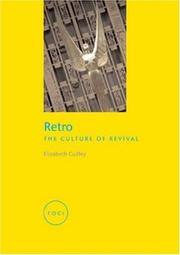| Listing 1 - 4 of 4 |
Sort by
|

ISBN: 9781861892904 Year: 2006 Publisher: London Reaktion
Abstract | Keywords | Export | Availability | Bookmark
 Loading...
Loading...Choose an application
- Reference Manager
- EndNote
- RefWorks (Direct export to RefWorks)
"Drawing upon a wealth of original research and anecdotal material, Guffey unearths the roots of the term retro and chronicles its manifestations in culture and art throughout the last century. From the comeback of Art nouveau nearly fifty years after its original decline to the infusion of Art Deco into the kitsch glamour of Pop art, the idea of retro has often meant a re-emergence of styles and fashions that evoke familiar touchstones of memory from the not-so-distant past, such as the drug-induced surrealism of psychedelic art and the political expressions of 1970s afros. Reinforcing such tends in art, design, fashion and music, advertisers and the media have seized upon the power of cultural nostalgia to promote a surprising range of products."--Jacket.
retro --- trend --- Popular culture --- Memory --- Nostalgia. --- Clothing and dress --- Fashion --- Design --- Retromarketing. --- History. --- Social aspects. --- Retention (Psychology) --- Intellect --- Psychology --- Thought and thinking --- Comprehension --- Executive functions (Neuropsychology) --- Mnemonics --- Perseveration (Psychology) --- Reproduction (Psychology) --- Retro marketing --- Marketing --- Creation (Literary, artistic, etc.) --- Society and clothing --- Nostalgia --- Retromarketing --- History --- Social aspects
Book
ISBN: 1282263986 9786612263989 1861894767 Year: 2006 Publisher: London : Reaktion Books,
Abstract | Keywords | Export | Availability | Bookmark
 Loading...
Loading...Choose an application
- Reference Manager
- EndNote
- RefWorks (Direct export to RefWorks)
Drawing upon a wealth of original research and entertaining anecdotal material, Guffey unearths the roots of the term "retro" and chronicles its evolving manifestations in culture and art throughout the last century.
Agoraphobia. --- Phobic disorders. --- Space (Architecture). --- Medicine. --- Manners & Customs --- Anthropology --- Social Sciences --- Agoraphobia --- Agoraphobia in literature --- Space (Architecture) --- Environment --- Geographic Locations --- Social Change --- Humanities --- Anxiety Disorders --- Environment and Public Health --- Ecological and Environmental Phenomena --- Geographicals --- Mental Disorders --- Sociology --- Cities --- Art --- Urbanization --- Psychiatry and Psychology --- Health Care --- Biological Phenomena --- Phenomena and Processes --- Anthropology, Education, Sociology and Social Phenomena --- Psychiatry --- Health & Biological Sciences --- Psychiatric Disorders, Individual --- History --- Social aspects --- Psychological aspects --- Popular culture --- Memory --- Nostalgia. --- Clothing and dress --- Fashion --- Design --- Retromarketing. --- History. --- Social aspects. --- Retro marketing --- Marketing --- Creation (Literary, artistic, etc.) --- Society and clothing --- Retention (Psychology) --- Intellect --- Psychology --- Thought and thinking --- Comprehension --- Executive functions (Neuropsychology) --- Mnemonics --- Perseveration (Psychology) --- Reproduction (Psychology)
Book
ISBN: 178023371X 9781780233710 Year: 2014 Publisher: London : Reaktion Books
Abstract | Keywords | Export | Availability | Bookmark
 Loading...
Loading...Choose an application
- Reference Manager
- EndNote
- RefWorks (Direct export to RefWorks)
Book
ISBN: 1350004243 1350004251 Year: 2018 Publisher: London: Bloomsbury Academic,
Abstract | Keywords | Export | Availability | Bookmark
 Loading...
Loading...Choose an application
- Reference Manager
- EndNote
- RefWorks (Direct export to RefWorks)
Designing Disability traces the emergence of an idea and an ideal - physical access for the disabled - through the evolution of the iconic International Symbol of Access (ISA). The book draws on design history, material culture and recent critical disability studies to examine not only the development of a design icon, but also the cultural history surrounding it. Infirmity and illness may be seen as part of human experience, but 'disability' is a social construct, a way of thinking about and responding to a natural human condition. Elizabeth Guffey's highly original and wide-ranging study considers the period both before and after the introduction of the ISA, tracing the design history of the wheelchair, a product which revolutionised the mobility needs of many disabled people from the 1930s onwards. She also examines the rise of 'barrier-free architecture' in the reception of the ISA, and explores how the symbol became widely adopted and even a mark of identity for some, especially within the Disability Rights Movement. Yet despite the social progress which is inextricably linked to the ISA, a growing debate has unfurled around the symbol and its meanings. The most vigorous critiques today have involved guerrilla art, graffiti and studio practice, reflecting new challenges to the relationship between design and disability in the twenty-first century.
Barrier-free design --- International Symbol of Access. --- Signs and symbols --- History. --- Social aspects --- History.
| Listing 1 - 4 of 4 |
Sort by
|

 Search
Search Feedback
Feedback About UniCat
About UniCat  Help
Help News
News